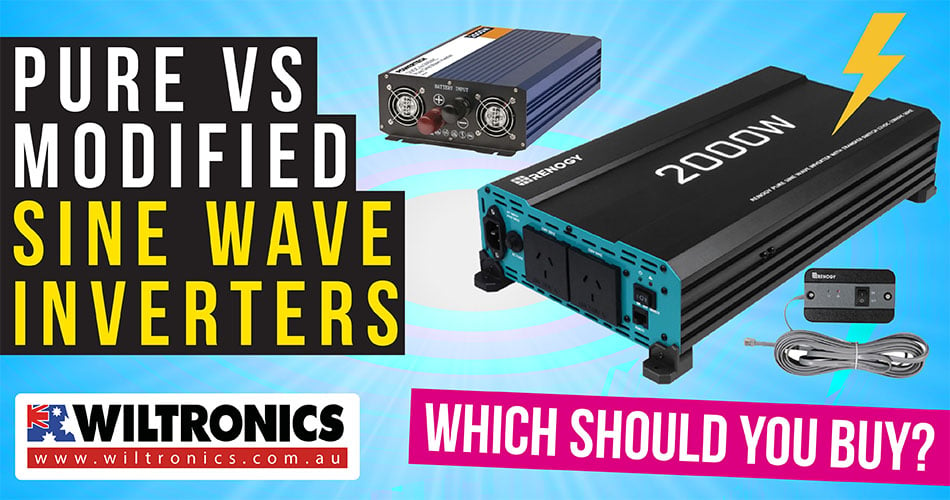Pure vs Modified Sine Wave Inverter: Which Should You Buy?
August 16, 2022

Solar inverters are excellent substitutes for power grids. But there are two types you must consider: pure vs modified sine wave inverter.
Inverters are one of the most important components in a solar installation. They turn the power produced from solar panels and stored in the battery from DC to AC power.
The common varieties of inverters available on the market are pure and modified sine wave. They have the same kind of electric power to run your appliances, as is supplied by the grid.
When shopping for one, you will come across those two, but which one suits your needs best? Here, we will break down the differences between pure vs modified sine wave inverter.
Read ahead to know how they work and what may be the ideal inverter for you to use in your installation.
How Do Solar Inverters Work?
Inverters act as the gateway between the PV system and the devices drawing energy from the panel. Generally, all solar inverters have the same basic task.
They alter the DC (direct current) output from the panel into AC (alternating current).
Most home appliances use AC energy, so the energy produced for your panels (DC) needs to be converted. On top of converting DC to AC, solar inverters can also change the voltage.
How do solar panels and inverters work together? First, the solar panel collects sunlight and turns it into energy. This will then get sent through the solar charge controllers and inverters.
The inverter will convert that power to AC energy. From there, you can plug in your appliances and make use of them, whether you are at home or outdoors.
There are actually three solar inverter models that you can choose for your solar panel. Each of them works slightly different, and one of them is the pure sine wave. The rest are the modified, as mentioned, and the square wave.
Note: We will only focus on the differences between pure and modified sine wave inverters.
Pure vs Modified Sine Wave Inverter
Both of these inverters convert DC from batteries into what approximates an AC supply. But they have significant trade-offs, offering unique features as well as advantages.
There are three main differences between pure vs modified sine wave inverter:
- Cost
- Efficiency
- Interference
1. Cost and efficiency
When it comes to the cost, modified sine waves are simpler to produce with fewer components. This makes them cheaper than their pure counterparts.
Pure sine wave may be more expensive to produce, thus making it a bit costly. But it provides more efficient power and minimal interference.
As for the modified efficiency, it produces smaller wave power than the pure. It uses up to 30% more power and cannot run its full capacity. This could cause a buildup of excess waste heat, damaging the equipment long-term.
2. Interference
The pure sine wave’s output voltage waveform has very low harmonic distortion. In contrast, modified could result in interference when powering clocks and audio devices.
A great example is a radio that produces a buzzing sound during the operation.
Defining Pure Sine Wave Inverters
A pure sine wave inverter output voltage comes in the form of sine waves. In a sine wave, the voltage rises and falls smoothly with a changing frequency.
Then, it changes its polarity instantaneously when it crosses 0 volts. It produces power that equals or is better than the power at home. This protects even the most sensitive electronics.
Generally, pure sine wave inverters are ideal for home appliances and devices, such as:
- Digital microwaves
- Televisions
- Fridges
- Laptops and other electronic equipment
- Appliances with AC motors and electronic timers or digital clocks
- Medical equipment, such as CPAP machines with humidifiers
- Laser printers
- Newer TV’s
They also produce cleaner, smoother, quieter, and more reliable electricity. Great features to have, especially if you wish to operate electronics without interference.
Defining Modified Sine Wave Inverters
In a pure sine wave, the AC power produced by the inverter closely matches the actual sine wave. In a modified sine wave, on the other hand, the polarity switches from positive to negative.
The wave has a stair-step and square pattern wherein the polarity goes back and forth. Keep in mind that a choppy wave can negatively affect sensitive equipment.
Now suppose you have medical equipment that you need to power, such as a CPAP machine. Using a modified sine wave inverter is not advisable.
This kind of sine wine inverter can be used in simple systems, though. If there is no AC motor, such as you would find on a delicate piece of medical equipment, you can use a modified inverter. Old tube TVs, water pumps, and phone chargers usually operate fine with this inverter as well.
Note: Electrical polarity is the direction of current flow in an electrical circuit. There are two types of poles: positive (+) and negative (−).
Get Your Sine Wave Inverters Here!
Here, we offer both pure and modified sine wave inverters. Both units feature modernised designs, are portable and allow for easy operation.
Pure vs Modified Sine Wave Inverter: The Verdict
Pure sine wave inverters are a more sophisticated option. And as their cost continues to drop, they become more affordable.
But modified sine wave inverters still make a viable option. One is enough and should do the work well if you have limited and simple appliances to power.
But if you want a unit that runs safely, effectively, and at the highest efficiency? In that case, we recommend investing in a pure sine wave inverter!
This article was originally published in December 2020 and has been updated.
© Electrotech Brands Pty Ltd 2022


Write a Comment
You must be logged in to post a comment.